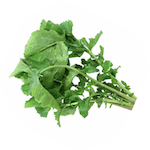Turnip

Turnip
Short facts : It is valued for its sweet and slightly peppery flavour and tender texture
This turnip is one of the most common types mostly white skin, apart from the upper 1 to 6 centimetres, which are purple, red or greenish, because it is above the ground where the sun hits. It is a root vegetable that belong to the Brassicaceae family, which also includes vegetables like cabbage, broccoli, and radishes. This turnip variety is valued for its sweet and slightly peppery flavour and tender texture. When cooked, the turnip retains its vibrant color, adding a visually appealing element to dishes. It can be eaten raw or cooked and is often roasted, sautéed, mashed or used in soups and stews adding depth and flavour. They are a good source of essential nutrients such as vitamin C, fiber, potassium and folate. In addition to their nutritional benefits, turnips are low in calories and can be a healthy addition to a balanced diet.

Turnip leaves
Short facts : They have a slightly bitter flavour similar to mustard greens
Turnip leaves are the green and leafy tops of the turnip plant, which are often discarded by consumers but are actually edible and nutritious. They have a slightly bitter flavour similar to mustard greens and can be eaten raw in salads or cooked in a variety of ways, such as sautéed, steamed or added to soups and stews. Turnip leaves are rich in vitamins A, C, and K, as well as minerals like calcium and iron. They are a great way to reduce food waste and add a healthy green vegetable to your diet.